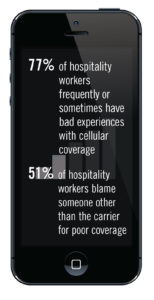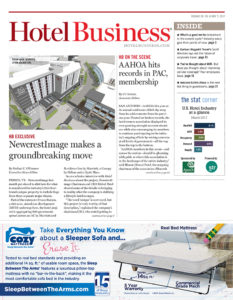DALLAS—How important is having good cellular coverage in hotels really? Like most other technology problems, the answer to that question is clear—it’s very important.
Zinwave, a company that makes in-building wireless infrastructure solutions that eliminate coverage problems for cellular, public safety and WiFi users, recently conducted a workplace survey across several different verticals to determine employees’ thoughts on coverage issues. Scott Willis, president/CEO of the company, said that the reason for the survey was to “figure out how to optimally attack the market from a sales, marketing, messaging and partnering perspective.”
Willis added the mobile world is shifting. A few years ago, carriers made the investment in distributed antenna systems that boosted indoor cellular signals for their customers in large venues like airports and arenas, but with increased mobile demand, the carriers no longer have the time or money to invest in indoor signal amplification—this now falls to the building’s owner, manager or enterprise.
“The shift to the enterprise is great—we think it’s going to enable and position this segment of the wireless industry to really take off and scale as investment and capital begins to be deployed in these different venues where mobile coverage needs to improve—but what we’re finding out is those entities aren’t necessarily prepared to make those decisions,” Willis said. “The complexity is much greater than a lot of us anticipated because we come from the industry and we’re used to working with the operators. They have lots of employees who are very knowledgeable, and when you transfer that decision process and investment responsibility over to the enterprise, what we’re quickly learning is that same level of expertise doesn’t exist. How do you approach that and solve the problem for that particular end user in that environment?”
The answer, of course, is education. “Education is becoming paramount for our success…to reach a point where enterprise is going to feel comfortable making these kinds of decisions, knowing that they’re making the right technology choice for their environment today, and they’re also making the right technology choice for their environment two or six years down the road; whatever decision they make today, they’re not going to have to rip it out in two years because of the shift that’s taken place in technology in the market,” he said, likening it to the education about WiFi that’s occurred. “Now, when you’re looking at the cellular layer in buildings, I think what we’re experiencing a little bit is a similar education curve that the enterprise experienced a number of years ago with WiFi.”
And, said Willis, cellular coverage is a problem. The survey found that 74% of workers complained that they had problems with poor cellular coverage in the workplace either “frequently” or “sometimes.” For hospitality in particular, that number jumps to 77%. The survey also found that millennial workers are 68% more likely to complain of frequent problems with cellular coverage than their coworkers. In addition, people are beginning to lay blame beyond the carrier’s feet. For instance, the survey found that millennials are 58% more likely to blame the employer when there is a connectivity issue, while, overall, 51% of hospitality workers blame someone other than the carrier. Willis noted that for hotels, if employees have a problem with poor cellular coverage, guests do as well—which could mean both a productivity problem and a guest satisfaction one.
 “There’s a high level of dissatisfaction of the mobile experience when you get into an indoor environment,” Willis said, pointing to the effect this has “on a company’s ability to get maximum or optimal efficiency out of their workforce, their ability to draw and attract the right caliber of workforce in terms of delivering the tools and the capabilities that particular workforce wants to participate in.”
“There’s a high level of dissatisfaction of the mobile experience when you get into an indoor environment,” Willis said, pointing to the effect this has “on a company’s ability to get maximum or optimal efficiency out of their workforce, their ability to draw and attract the right caliber of workforce in terms of delivering the tools and the capabilities that particular workforce wants to participate in.”
He noted that cellular coverage issues will continue to exacerbate. Many hotels use mobile devices to communicate with employees who are generally mobile themselves, unattached to a guest. In addition, IoT applications represent a huge ability to improve the guest experience—but will have an effect on cell usage. “If you think about some of the physics of the industry, in-building penetration globally is about 2%, and obviously that varies in more mature markets; data growth continues almost on a vertical trend,” Willis said, pointing to the “very aggressive movement in the market toward bring-your-own-device or enterprises not wanting to get tied into the device aspect with the employee now responsible for that. The trend that’s beginning to create and the data points out of the survey are that much more compelling in terms of how do those employers work to solve that problem and address the in-building mobile communication experience.”
Willis noted the hospitality industry should be on the lookout for a few things over the next few years. “Very different than some other particular verticals, what’s critical to the hospitality space is a multi-carrier environment. It’s important to the hospitality vertical that they’re able to support in North America Sprint, T-Mobile, Verizon and AT&T because their customers are going to be coming from those four customers,” he said.
“Second, when you think about versatility of all of the various applications that the hospitality vertical would like to offer its end users, the importance of having a fiber infrastructure to support that is important to the investment choice or the technology partner choice as they look comprehensively across the suite of applications for the end users,” Willis said. “The flexibility, the benefits and the broad reuse of that fiber plant that’s run throughout their venue is an important part of the decision.
“If you think about broad IoT applications, not only how to use that internally within the employee base, but how do they increase the IoT applications and integrate their customer base to improve their experience, is going to be an important piece,” he continued.
And finally, hotels need to think about 5G and how it will enable IT. Hotels “need to pick a partner that can not only meet the demands and provide the value propositions we’ve discussed, but can also address some of those future platforms and technology choices that are going to be critical to the growth and future success of their business,” Willis concluded. HB

